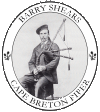Archival Recordings
Archival Recordings include several interviews and performances from my personal collection.
- Archie MacKenzie Interview, Halifax, c. 1989. Discussing the tunes Over the Isles to America as a march and Duntroon’s Reel. Archie ‘jigs’ the two tunes and offers a glimpse of a Ceilidh in 1937 in Christmas Island with John Lorne Campbell. I got to know Archie after I had moved to Halifax once again in the early 1980s. He was a great source of stories and songs about pipers and pipe music in Cape Breton.
- Alex Currie, House Party, Reels, c. 1971. Sleepy Maggie; Am Muileann Dubh (The Black Mill); Buntàta Carrach (Scabby Potatoes); An Oidhche a Bha na Gobhair Againn (The Night we had the Goats); ; Ruidhle nan Innseanach (The Indian Reel); The Cameronian Rant, Sleepy Maggie. Alex learned much of his music from his mother and grandmother’s singing and he had some ‘tasty’ settings of many traditional pipe tunes. . These tunes can be found in “Play It Like You Sing It” Volume 2.
- Joe Hughie MacIntyre pipes / probably Marie Maclellan, piano, c. 1968: John Morrison of Assynt House; Scorrybreck Falls; Angus Ross of Kirtomy. Joe Hughie learned to read music after he retired and these tunes reflect his interest in modern reels, played with a strong dance rhythm.
- Barry Shears, reels, c. 2010: Cabar Féidh, Beaver Cove Reel; Ruidhle nan Innseanach (The Indian Reel); Cabar Féidh (2nd setting). A few tunes recorded in my living room in Halifax back in 2010. These tunes, with slight variations, can be found in “Play It Like You Sing It” Volume 2.
- Theresa Burke, Making Practice Chanters in Cape Breton. Sydney, 2014. Theresa was descended from a long line of pipers which included her mother, two uncles, and grandfather, Rory ‘Shim” MacIsaac, Bein Eoin. Rory “Shim” learned to play the bagpipes and violin from his maternal uncle, Simon Gillis, who in turn learned from his father, John Gillis, a veteran of the Napoleonic wars.
- Duncan MacIntyre, Sydney, c. 1972, The Reel of Tulloch. This recording was made at the home of Duncan’s nephew, Pipe Major Danny MacIntyre. Duncan and Joe Hughie were brothers. Duncan was also a fiddler and was a piper with the North Nova Scotia Highalnders during World War Two. He was one of several pipers selected to attend month long course at Edinburgh Castle with legendary Scottish piper, Willie Ross. The Reel of Tulloch, with extended variations was published by David Glen in the 19th century and Duncan ‘s setting differs from the Scottish version. More recently this settting has been published in “Play It Like You Sing It” Volume 2.
- Sandy Boyd, (GHB), c 1965, Sydney, Cape Breton. Piobaireachd: The Groat. Sandy immigrated to Nova Scotia during the Second World War. He was actually in the merchant marine, but when the officer of the Pictou Highlanders, then stationed at the Halifax Citadel heard him play, he ordered the gates to the fort locked and Sandy missed his ship leaving. He joined the Pictou Highlanders and after the War he traveled around Nova Scotia teaching and performing. In Scotland he was a pupil of John MacColl and Robert Reid, and his playing of this tune reflects an older style of piobaireachd performance.
The Groat
Marches (GHB, Piano)
Trossack Eugene trip

